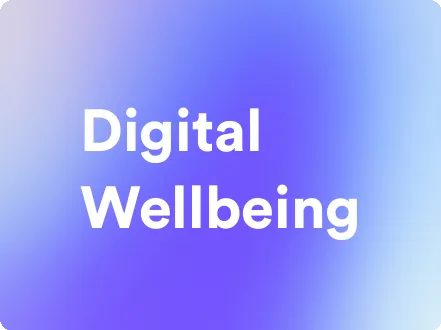Phones, tablets, and laptops are now central to the way we work, relax, and socialize. This connectivity can be helpful, but it can also lead to burnout, distraction, and the feeling of always being “on.” Finding a balance is the key to a healthy relationship between technology and you. It’s not about completely disconnecting but finding a sustainable solution. This guide will show you how to incorporate simple and effective digital wellness practices into your daily life to gain control of your life, improve it, and live a more balanced, healthier lifestyle. We can reduce stress and improve our focus by being more deliberate with our tech usage.
Take a Mindful Approach to Tech Use
It’s not just about meditation. Mindfulness can also be applied to digital habits. When you use a tech device, being mindful means that you are present and deliberate. Ask yourself why you are reaching for your phone instead of unlocking it to browse social media. Are you looking for directions or checking an important email? Are you responding to a sense of alertness or boredom, or are you simply reacting? You can stop the mindless scrolling by pausing and thinking about your intentions. This small change can help you reduce the amount of time you spend using your phone and feel more in charge of your digital life.
Set Clear Digital Boundaries
It is important to set boundaries to protect your mental and physical energy. Work can easily spill over into your personal life, and notifications can overwhelm you. Turning off notifications that are not essential is a simple but powerful way to set boundaries. Do you need to be notified every time someone comments on your photo or when a new email appears in your promotional tabs? You can use your phone to your advantage by limiting alerts to the most important apps. Schedule specific times to check emails and social media. Set aside blocks of time in your schedule to catch up on emails and social media. This method allows you to focus on your priorities and avoid interruptions.
Tech-free Zones and Times
You can improve your health by designating specific areas in your home as “tech-free zones.” Start in the bedroom. Keep phones and laptops away from your bedroom to improve the quality of sleep. The blue light from screens interferes with melatonin. You can also wind down by reading a book or having a conversation instead of scrolling. Making mealtimes technology-free will improve your relationship with your family and your relationship with your food. You can have more meaningful conversations during meals and better digestion by putting away your devices. These designated areas help you create the separation you need between your online and offline lives.
Prioritize Meaningful Offline Activities
Filling your time with offline activities that you enjoy is one of the best ways to improve digital wellness. Passion for your hobbies and interests will naturally draw you away from your digital devices. Think about the activities you enjoy when you’re not interacting with screens. You could do anything, from gardening and hiking to cooking or playing an instrument. You can schedule these activities to ensure you have time set aside for them. Another great way to build real connections is by making plans that do not involve screens. The more time you spend in the offline world, the less likely you are to look for entertainment or validation from digital media.
Cultivate Mental Clarity Through Digital Detoxes
It’s possible to feel overwhelmed by digital media even with the best of habits. A digital detox is a wonderful way to combat this. It doesn’t mean you have to go on a retreat for a whole week without your phone. You can do a simple “digital sunrise” where you turn off all of your devices a few hours prior to bedtime. Try a tech-free week every month. You want to rest your brain from the constant stimulation that comes with the digital world. You can use this time to reconnect with yourself, be in nature, or just be. These breaks can reset your mind and improve your focus. They also remind you to enjoy life outside of your screen.
Your Path to a Healthier Digital Life
Finding balance in technology is a continuous practice and not an instant fix. You can create a more healthy and intentional relationship with your device by integrating mindfulness, setting boundaries, creating tech-free zones, and prioritizing the offline connection. These habits will help you take charge of your digital world, reduce stress, and create more space for the things that matter.
FAQs
1. What is digital well-being?
Digital wellness is the act of maintaining a healthy relationship with technology. Digital wellness involves knowing when and how you use your digital devices to make sure they are supportive rather than detrimental to your well-being.
2. How can I reduce screen time without feeling disconnected from the world?
Set up a schedule to check your social media and email at specific times. You can stay informed and avoid constant interruptions. Focus on engaging offline activities as a way to replace screen time and build stronger connections.
3. What is “digital detox”?
Digital detoxing is the deliberate abstinence from digital devices such as smartphones and computers. The digital detox can last from a few days to several hours and is intended to reduce stress and improve focus.
4. Why do we need tech-free zones at home?
It is important to create tech-free zones in your home, like the bedroom and dining room. This helps you establish healthy boundaries between digital life and personal life. It can help improve your sleep, promote meaningful social interaction, and give you a mental break.
5. How can digital well-being improve my mental health?
Digital wellness has the potential to alleviate anxiety, comparison, and information overload, which are frequently associated with social media and continuous alerts. You can improve your mental space and calmness by being more deliberate with your tech usage.




